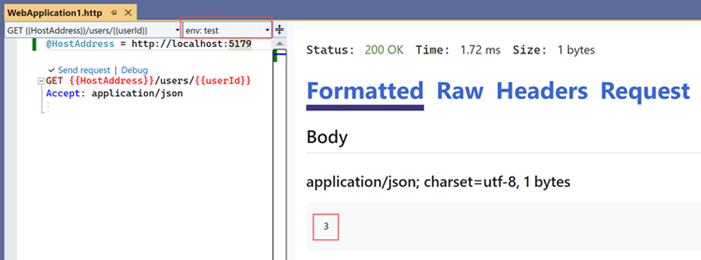In this post, let's get to know some different ways to manage variables within
HTTP Files.
Let's consider the following simple API.
WebApplicationBuilder builder = WebApplication.CreateBuilder(args);
WebApplication app = builder.Build();
app.MapGet("/users/{userId}", (int userId) =>
{
return userId;
});
app.Run();
1. Use Inline Variables
You can define the variables in the .http file itself as follows
@HostAddress = http://localhost:5179
@userId = 1
GET {{HostAddress}}/users/{{userId}}
Accept: application/json
You can define an environment file with the name httpenv.json. The
file can be in the same folder as in the .http file or a folder above
it. Visual Studio will look for that file in the folder where the HTTP
file exists. If it’s not found, Visual Studio will look through the parent
directories to find it. When a file is found named httpenv.json, Visual
Studio will stop searching for the file. The nearest file to the HTTP file
found will then be used.
Here, I am just going to add httpenv.json next to the
.http
file.
{
"development": {
"userId": 2
},
"test": {
"userId": 3
}
}
Now I am closing and opening up the .http file (in order for the
environment file to be picked), removing @userId = 1 defined in the .http file. Now because of
the httpenv.json, I can see the environments in a dropdown as
follows.
Now based on the environment we are selecting, I will get different values.

|
| Environments |

|
| Environment: development |

|
| Environment: test |
3. Use a user-specific environment file
You can also add a user-specific environment file
named httpenv.json.user, next to the httpenv.json
file.
{
"development": {
"userId": 4
}
}
And now when you execute the request, you can see the following output.

|
| User-specific environment file |
The order of precedence for the variables is below. Once a match is found
that value will be used, and other sources ignored.
- Variable declared in the .http file
- Variable declared in the httpenv.json.user file
- Variable declared in the httpenv.json file
Hope this helps.
Regards,
Jaliya
Jaliya

No comments:
Post a Comment